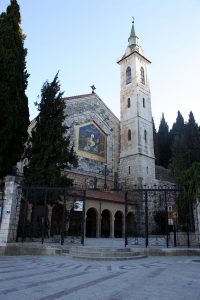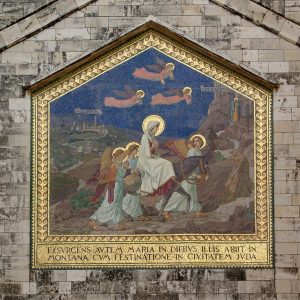46 And Mary said,
“My soul magnifies the Lord,
47 and my spirit rejoices in God my Savior,
48 for he has looked with favor on the lowliness of his servant.
Surely, from now on all generations will call me blessed;
49 for the Mighty One has done great things for me,
and holy is his name.
50 His mercy is for those who fear him
from generation to generation.
51 He has shown strength with his arm;
he has scattered the proud in the thoughts of their hearts.
52 He has brought down the powerful from their thrones,
and lifted up the lowly;
53 he has filled the hungry with good things,
and sent the rich away empty.
54 He has helped his servant Israel,
in remembrance of his mercy,
55 according to the promise he made to our ancestors,
to Abraham and to his descendants forever.” [Luke 1:46-55, NRSV]
- Church of the Visitation, Ein Karim, exterior view.
- Mosaic façade on Mary hastening from Nazareth.
- Visitation, by Sebastiano del Piombo, 1518-19.
Ein Karim enjoys special prominence on the itinerary of Christian Pilgrimage to the Holy Land as the home to the Church of the Visitation, which honours the visit paid by the Virgin Mary, the mother of Jesus, to Elizabeth, the mother of John the Baptist (Luke 1:39–56). This is thus the site where tradition says that Mary recited her song of praise, the Magnificat. This is also where the Church of St. John the Baptist, commemorating St. John’s birth, is located.
In most pilgrim groups there are members who, no longer agile with their feet, will at first find the long slope leading up to the Church of the Visitation rather daunting to climb. So far, with some help, everyone we know eventually managed the climb.
At the foot of the slope is the famous Mary’s Well, where it is believed that Mary drank from its spring waters while sitting with Elizabeth.
Half way up the slope is the Convent of the Sisters of the Rosary whose religious articles shop our guide urged us to patronize. It is well stocked with their handmade rosaries.
Only 20 minutes drive from the city of Jerusalem, it is a respite from the bustle of the busy city and its crowded tourist centres. Adding to the respite is the lush greenery dotted by beautiful bright flowers announcing the name Ein Karim – “spring of the vineyard”.
Reflection:
The Gospel of Luke gives us a beautiful Infancy narrative in which, as the angel Gabriel announced to Mary about God’s plan for her virgin birth of the Son of God, he also informed her that her kinswoman Elizabeth, even though barren and advanced in years, was already pregnant with child for six months. With God, the angel affirmed, “nothing will be impossible”. And Luke says Mary at once arose and “went with haste” to see Elizabeth (Luke 1:39) in what the Catholic tradition calls the “Visitation”. During the visit, Mary sang her famous “Magnificat” which has since become staple diet in Christian corporate and individual prayer life.
1. Mary the Person
In relation to the Visitation, it is well, we think, to clarify three things about Mary.
- First, Mary was a very young and simple country girl. She lived like everyone else who was not well to do, and that included living in one of the many caves in the countryside which commonly would be home in one section and a place to keep animals in another section, especially in cold winter nights. Like other Israelites of her time, Mary would be yearning for God to bring them liberation – from poverty but, perhaps even more importantly, from servitude under oppressive foreign power which in the present case was the Roman occupiers.
- Second, even though young and simple, Mary was capable of making quick decisions and taking swift actions. She needed to see Elizabeth, to render her much needed assistance in preparation for the birth of her child. To do so, she had to travel that difficult journey from Nazareth to Ein Karim, located in the hill country of Judah. Luke said, quite simply, “she arose and went with haste”; she was decisive and swift.
- Third, however, just as we have noted Mary’s ability to make quick decisions and take swift actions, all the more must we note with clarity that the Gospel of Luke also presents with intensity the thoughtful and meditative side of Mary. On two occasions, the Gospel describes her mulling over the whole thing in her mind as she went about her life (Luke 2:19, 51). The Magnificat goes further and reveals her deep sense of justice and an ability to express trenchant social criticism (Luke 1:46-55).
2. Mary’s Song of Praise
On arrival at Elizabeth’s house, when the voice of Mary’s greeting came to the ears of Elizabeth, the baby John the Baptist in Elizabeth’s womb leaped for joy. Elizabeth praised Mary for her faith in words that now form a key portion of the Hail Mary, and Mary responded with what is now known as the Magnificat. “Magnificat” is Latin for “(my soul) glorify”. It is Mary’s song of praise for the Almighty God.
Taken directly from the Gospel of Luke (1:46-55), Mary’s Magnificat continues the theme of promise-and-fulfillment in Luke’s infancy narrative and constitutes one of four hymns (or canticles) in that category. The other three are Zechariah’s Benedictus (1:67–79); the angels’ Gloria in Excelsis Deo (2:13–14); and Simeon’s Nunc dimittis (2:28–32).
It is rare, if ever, for ordinary Christians in ordinary parishes around the world to hear the verses of Mary’s Magnificat preached in relation to emphasizing the God of social justice who has shown mercy on the one hand as He meted out justice on the other hand. He has:
- regarded the low estate of His handmaiden and has done great things for her,
- shown mercy on those who fear him and scattered the proud-hearted,
- brought down the powerful from their thrones and lifted up the lowly,
- filled the hungry with good things and sent the rich away empty.
This portrayal of the very essence of who God is and what He does is soon followed by the promise of the Son of God himself in the synagogue in Nazareth as he reads from the Isaian scroll:
- “The Spirit of the Lord is upon me, because he has anointed me to bring good news to the poor. He has sent me to proclaim release to the captives and recovery of sight to the blind, to let the oppressed go free, to proclaim the year of the Lord’s favor” (Luke 4:18-19).
Rare as it may be, wherever one gets to hear this line of spirited preaching on Mary’s Magnificat, one will begin to give a different sort of credit to Mary who now:
- seems more like a rebel intent on, or at least applauding any attempt at, reorienting unjust systems; and
- less like a scared, pious, and obedient teenager wholly obedient and submissive to the “system” and the people who run the system.
“Obedience”, we may then understand, cuts two, potentially contrary, ways.
- The first is in the sense of religious obsequience. Religious authorities, unless they have seriously taken on board the values of Jesus to heart, have a typical penchant to demand, by words or implicit actions, that members of their religion be obsequiously respectful towards them and obedient to everything they say. “Obsequious” is an adjective defined as “obedient or attentive to an excessive or servile degree.” An exaggerated case would be a bishop preaching at an early morning Mass pointing menacingly at the small congregation (intending for them to tell the larger body of the Laity outside), declaring in a self-righteous tone: “You lay people listen good, we are the ones to decide.” .
- The second is spiritual obedience to God. This is the obedience owed by all members of a religion, leaders and the rest. Spiritual obedience to God may legitimately involve outright disobedience to religious leaders where the demands of the latter are clearly contrary to God’s will. So Peter and the apostles defiantly answered the religious leaders: “We must obey God rather than men” [Acts 5:29].
This is the Mary of the Magnificat we need to fall in love with. Throughout history, poor and oppressed people had often identified with her song to God. They like it so much because they can relate to a song sung from the heart by a poor, young, unmarried pregnant woman. They also know that it is the longest set of words spoken by a woman in the New Testament.
Saint Oscar Romero, priest and martyr of Latin America, drew a close comparison between Mary and the poor and powerless people in his own community. Gustavo Gutierrez, a renowned theologian, once wrote that we will miss the meaning of the text of the Magnificat with any “attempts to tone down what Mary’s song tells us about the preferential love of God for the lowly and the abused.” Dietrich Bonhoeffer, a German pastor and theologian who was executed by the Nazis, called the Magnificat “the most passionate, the wildest, one might even say the most revolutionary hymn ever sung.” As the revolutionaries, the poor and the oppressed express their love for Mary and emphasize her glorious song, we should not be surprised to find the powerful but lesser souls (souls that do not magnify the Lord God) in religious and secular leadership viewing the Magnificat as being dangerous. We certainly should not be surprised to see her song being “silenced” in many religious quarters.
3. Mary’s Magnificat for Us Today
The God at work in the Magnificat is a liberating, mighty, and merciful God who is faithful to his promises. This God sides with justice and peace for all — not just for the rich, but more so for the Poor as they are more deserving. If the Magnificat has resonance in us, we will make sure the Poor get the present they have longed for from the God who brings it, and that present is justice.
Charity and humanitarian work are at their best when we forget about doing “charity” and “good works”, but are committing ourselves to doing justice for and on behalf of God in favour of people to whom society owes justice. “They are poor, because we are rich,” becomes our own spiritual battle cry, our motivation to do something right by God for His Poor.
Copyright © Dr. Jeffrey & Angie Goh, Novemmber 2019. All rights reserved.
You are most welcome to respond to this post. Email your comments to jeffangiegoh@gmail.com. You can also be dialogue partners in this Ephphatha Coffee-Corner Ministry by sending us questions for discussion.



